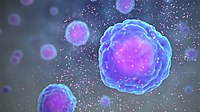
Photo from wikipedia
Cryopreservation is a common strategy for the preservation of biological cells and tissues. While conventional platforms such as cell culture well plate systems enable measuring cell responses to various cryoprotectants,… Click to show full abstract
Cryopreservation is a common strategy for the preservation of biological cells and tissues. While conventional platforms such as cell culture well plate systems enable measuring cell responses to various cryoprotectants, the drawbacks associated with capturing and imaging of cells limit the utility of such systems. Microfluidic technologies facilitate the capturing, chemical stimulation, and imaging of cells using low sample volumes. Here, we utilized microfluidic technologies for the hydrodynamic capturing of single human monocytes and studying the cell volume kinetics in response to a cryoprotectant in real time. Our approach facilitates conducting multistep cellular assays, especially for studying individual cell osmotic response and determining cell membrane permeability to cryoprotectants.Cryopreservation is a common strategy for the preservation of biological cells and tissues. While conventional platforms such as cell culture well plate systems enable measuring cell responses to various cryoprotectants, the drawbacks associated with capturing and imaging of cells limit the utility of such systems. Microfluidic technologies facilitate the capturing, chemical stimulation, and imaging of cells using low sample volumes. Here, we utilized microfluidic technologies for the hydrodynamic capturing of single human monocytes and studying the cell volume kinetics in response to a cryoprotectant in real time. Our approach facilitates conducting multistep cellular assays, especially for studying individual cell osmotic response and determining cell membrane permeability to cryoprotectants.
Journal Title: Applied Physics Letters
Year Published: 2019
Link to full text (if available)
Share on Social Media: Sign Up to like & get
recommendations!